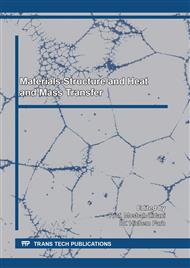[1]
N. A. C. Sidik et al., Recent progress on hybrid nanofluids in heat transfer applications: A comprehensive review, International Communications in Heat and Mass Transfer 78 (2016) 68-79.
DOI: 10.1016/j.icheatmasstransfer.2016.08.019
Google Scholar
[2]
M. Benkhedda, T. Boufendi and S. Touahri, Laminar mixed convection heat transfer enhancement by using Ag-TiO2-water hybrid nanofluid in heated horizontal annulus, Heat and Mass Transfer (2018).
DOI: 10.1007/s00231-018-2302-x
Google Scholar
[3]
G. Huminic, A. Huminic, The heat transfer performances and entropy generation analysis of hybrid nanofluids in a flattened tube, International Journal of Heat and Mass Transfer 119 (2018) 813-827.
DOI: 10.1016/j.ijheatmasstransfer.2017.11.155
Google Scholar
[4]
V. Kumar and J. Sarkar, Two-phase numerical simulation of hybrid nanofluid heat transfer in minichannel heat sink and experimental validation, International Communications in Heat and Mass Transfer 91 (2018) 239-247.
DOI: 10.1016/j.icheatmasstransfer.2017.12.019
Google Scholar
[5]
L. S. Sundar, M. K. Singh and A. C. M. Sousa, Heat transfer and friction factor of nanodiamond-nickel hybrid nanofluids flow in a tube with longitudinal strip inserts, International Journal of Heat and Mass Transfer 121 (2018) 390-401.
DOI: 10.1016/j.ijheatmasstransfer.2017.12.096
Google Scholar
[6]
D. D. Kumar and A. V. Arasu, A comprehensive review of preparation, characterization, properties and stability of hybrid nanofluids, Renewable and Sustainable Energy Reviews 81 (2018) 1669-1689.
DOI: 10.1016/j.rser.2017.05.257
Google Scholar
[7]
E. Azhar, E. N. Maraj and Z. Iqbal, Mechanistic investigation for the axisymmetric transport of nanocomposite molybdenum disulfide-silicon dioxide in ethylene glycol and sphericity assessment of nanoscale particles, The European Physical Journal Plus (2018) 133:130.
DOI: 10.1140/epjp/i2018-11958-3
Google Scholar
[8]
G.Y. Ny et al., Numerical study on turbulent-forced convective heat transfer of Ag/Heg water nanofluid in pipe, Journal of Advanced Research in Materials Science 22 (1) (2016) 11-27.
Google Scholar
[9]
D. Kashyap and A. K. Dass, Effect of boundary conditions on heat transfer and entropy generation during two-phase mixed convection hybrid Al2O3-Cu/water nanofluid flow in a cavity, International Journal of Mechanical Sciences (2019).
DOI: 10.1016/j.ijmecsci.2019.04.014
Google Scholar
[10]
H. R. Ashorynejad, MHD natural convection of hybrid nanofluid in an open wavy cavity, Results in Physics (2018).
DOI: 10.1016/j.rinp.2018.02.045
Google Scholar
[11]
S. Hussain, S. E. Ahmed and T. Akbar, Entropy generation analysis in MHD mixed convection of hybrid nanofluid in an open cavity with a horizontal channel containing an adiabatic obstacle, International Journal of Heat and Mass Transfer 114 (2017) 1054-1066.
DOI: 10.1016/j.ijheatmasstransfer.2017.06.135
Google Scholar
[12]
T. Hayat and S. Nadeem, Heat transfer enhancement with Ag-CuO/water hybrid nanofluid, Results in Physics (2017).
DOI: 10.1016/j.rinp.2017.06.034
Google Scholar
[13]
C. J. Ho et al., Preparation and properties of hybrid water-based suspension of Al2O3 nanoparticles and MEPCM particles as functional forced convection fluid, International Communications in Heat and Mass Transfer 37 (2010) 490-494.
DOI: 10.1016/j.icheatmasstransfer.2009.12.007
Google Scholar
[14]
A. M. Hussein, Thermal performance and thermal properties of hybrid nanofluid laminar flow in a double pipe heat exchanger, Experimental Thermal and Fluid Science (2017).
DOI: 10.1016/j.expthermflusci.2017.05.015
Google Scholar
[15]
R. R. Sahoo and J. Sarkar, Heat transfer performance characteristics of hybrid nanofluids as coolant in louvered fin automotive radiator, Heat Mass Transfer 53 (2017) 1923-1931.
DOI: 10.1007/s00231-016-1951-x
Google Scholar
[16]
A. Karimi and M. Afrand, Numerical study on thermal performance of an air-cooled heat exchanger: Effects on hybrid nanofluid, pipe arrangement and cross section, Energy Conversion and Management 164 (2018) 615-628.
DOI: 10.1016/j.enconman.2018.03.038
Google Scholar
[17]
A. M. Rashad et al., MHD Natural convection in a triangular cavity filled with a Cu-Al2O3/water hybrid nanofluid with localized heating from below and internal heat generation, Journal of Heat Transfer (2018).
DOI: 10.1115/1.4039213
Google Scholar
[18]
M. A. Mansour et al., Effects of heat source and sink on entropy generation and MHD natural convection of A Al2O3-Cu/water hybrid nanofluid filled with square porous cavity, Thermal Science and Engineering Progress (2017).
DOI: 10.1016/j.tsep.2017.10.014
Google Scholar
[19]
S. Suresh et al., Effect of Al2O3-Cu/water hybrid nanofluid in heat transfer, Experimental Thermal and Fluid Science 38 (2012) 54-60.
DOI: 10.1016/j.expthermflusci.2011.11.007
Google Scholar
[20]
C. Yang et al., Heat transfer performance assessment of hybrid nanofluids in a parallel channel under identical pumping power, Chemical Engineering Science (2017).
DOI: 10.1016/j.ces.2017.04.045
Google Scholar
[21]
H. Yarmand et al., Convective heat transfer enhancement with graphene nanoplatelet, platinum hybrid nanofluid, International Communications in Heat and Mass Transfer 88 (2017) 120-125.
DOI: 10.1016/j.icheatmasstransfer.2017.08.010
Google Scholar
[22]
M. Bahiraei, S. Heshmatian, Thermal performance and second law characteristics of two new microchannel heat sinks operated with hybrid nanofluid containing graphene-silver nanoparticles, Energy Conversion and Management 168 (2018) 357-370.
DOI: 10.1016/j.enconman.2018.05.020
Google Scholar
[23]
S. V. Patankar, Numerical heat transfer and fluid Flow, Hemisphere, Washington, DC (1980).
Google Scholar
[24]
S. Marzougui et al., Entropy Generation on Magneto-Convective Flow of Copper-Water Nanofluid in a Cavity with Chamfers, Journal of Thermal Analysis and Calorimetry (2020).
DOI: 10.1007/s10973-020-09662-3
Google Scholar
[25]
F. Mebarek-Oudina and R. Bessaih, Numerical simulation of natural convection heat transfer of Copper-Water nanofluid in a vertical cylindrical annulus with heat sources, Thermophysics and Aeromechanics 26 (3) (2019) 325-334.
DOI: 10.1134/s0869864319030028
Google Scholar
[26]
J. Raza et al., Magnetohydrodynamic flow of nano Williamson fluid generated by stretching plate with multiple slips, Multidiscipline Modeling in Materials and Structures 15(5) (2019) 871-894.
DOI: 10.1108/mmms-11-2018-0183
Google Scholar
[27]
J. Raza et al., Multiple Slip Effects on MHD Non-Newtonian Nanofluid Flow Over a Nonlinear Permeable Elongated Sheet : Numerical and Statistical Analysis, Multidiscipline Modeling in Materials and Structures 15 (5) (2019) 913-931.
DOI: 10.1108/mmms-11-2018-0190
Google Scholar
[28]
I. Zahan et al., Mixed convective hybrid nanofluid flow in lid-driven undulated cavity: Effect of MHD and Joule heating, Journal of Naval Architecture and Marine Engineering 16 (2019) 109-126.
DOI: 10.3329/jname.v16i2.40585
Google Scholar
[29]
F. Mebarek-Oudina, Convective heat transfer of Titania nanofluids of different base fluids in cylindrical annulus with discrete heat source, Heat Transfer-Asian Research 48(1) (2019) 135-147.
DOI: 10.1002/htj.21375
Google Scholar
[30]
B. Mahanthesh et al., Significance of exponential space- and thermal-dependent heat source effects on nanofluid flow due to radially elongated disk with Coriolis and Lorentz forces, Journal of Thermal Analysis and Calorimetry (2019).
DOI: 10.1007/s10973-019-08985-0
Google Scholar


